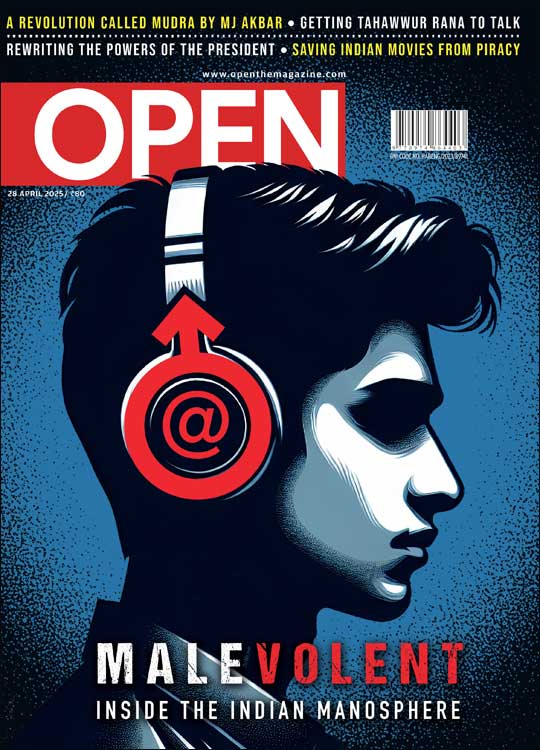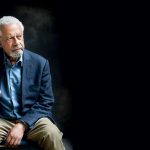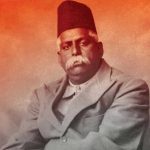The Case of the Missing Writer
In the midst of his research at the British Library in London, historian Gyan Prakash stumbled upon an incomplete manuscript of an action-packed thriller written by a Bombay-based Parsi in 1927. Here, Prakash tells the fascinating tale of how he tried to solve the mystery of the author’s identity as well as how the novel ends
 Gyan Prakash
Gyan Prakash
 Gyan Prakash
|
30 May, 2013
Gyan Prakash
|
30 May, 2013
/wp-content/uploads/2015/11/books-parsi.jpg)
A Princeton University professor’s obsessive hunt for a mysterious Parsi writer
The publication of The Tower of Silence, more than 85 years after it was penned by Mr Chaiwala, is a happy moment. Certainly, the author would have been pleased to see his rollicking novel in print.
I first encountered Phirozeshah Jamsetjee Chaiwala in the British Library, London in 2001. I was in the initial stages of research for my book, Mumbai Fables, wading through some documents from the 1920s. Reading the dry, official correspondence, I silently cursed the British Raj. As if ruling India was not bad enough, it had also condemned historians to struggle through the records of its tedious routines of government. Trawling through reams of documents to pick up bits of information about the past is a historian’s occupational hazard, but did the material have to be so dreary? I needed a break. Setting aside the stack of files on my desk, I began looking through the catalogue of the Oriental and India Office Collection’s European manuscripts for some light entertainment. My eyes glazed over as they moved from listing to listing, from the letters and diaries of this Governor-General to the private correspondence and papers of that Viceroy. Suddenly, an entry for Tower of Silence caught my eye. The catalogue described it as the typescript of a novel written in 1927. I immediately requisitioned it.
To my delight, when the typescript arrived, I discovered it was a detective novel. I put aside everything else and delved into it. Though I was not sure how it contributed to my research on Bombay, I was hooked. Here was something that matched the enchantment that the city held for me. The action was non-stop, full of twists and turns and, although it moved from place to place, Bombay was at its centre. For two straight days, I read nothing but Tower of Silence. But a disappointment awaited me. The typescript ended abruptly on page 169. It was clearly incomplete. Where was the rest?
In my pursuit of the concluding pages, I faced mystery after mystery. First, there was the author’s name in the typescript: Phiroshaw Jamsetjee Chevalier (Chaiwala). It was clear enough that he was a Parsi. But Chevalier was not a Parsi last name. Chaiwala had obviously adopted it. But why? I consulted a Parsi friend who offered one possible explanation. He suggested that the author might have adopted the last name of Maurice Chevalier. Apparently the gramophone records of the French actor and singer were popular among the Parsis in the 1920s. This was plausible, though Chaiwala deepened the mystery by rubberstamping the pages with the name of the publisher—PJ Chavalier and Co.—spelling the name with an ‘a’ rather than an ‘e’.
But whether spelt with an ‘a’ or an ‘e’, there was no record of this company as a publisher. In fact, in Thacker’s India Directory of 1927, it was listed as an export, import, and general commission agency with an office in Commissariat Building, Hornby Road, Bombay. Perhaps Chavalier & Co. decided to diversify its operations by entering publishing. But if it did, Tower of Silence, authored by the company’s sole proprietor, was one of its two publications—the other being Sixty- Seven Poems, a 100-page typescript also authored by Chaiwala.
Perhaps the sight of the publisher’s stamp caused the India Office in London to deposit it in the printed books collection on 5 June 1930. The Catalogue of Books Printed in the Bombay Presidency during the Quarter ending 30 September 1928 listed it as published on 15 May 1928, with a first edition consisting of 100 copies. It was transferred to the European manuscripts collection on 21 May 1976. Apparently the rubber stamp on the typescript no longer persuaded the library staff that the novel had been published. For Chaiwala, who must have believed the contrary, this would have been a terrible blow.
Who was Chaiwala? Or was it Chevalier or Chavalier? I gathered from reading his novel that he was a well-educated Parsi businessman from Bombay, fluent in English and with literary ambitions. He took the trouble not only to self-publish his novel with a hundred typescript copies but also mailed one copy all the way to the India Office Library, London. But apparently only an incomplete version had reached its destination.
A further search in the British Library did not yield the missing pages, but I was convinced they existed. The methodical unfolding of the narrative, and the way the typescript was numbered and divided into chapters convinced me that Chaiwala was a careful man. It seemed unlikely that he had written and put into circulation an incomplete novel. Perhaps the missing pages of the India Office copy had gotten lost in the binding process, or come loose somewhere between the original filing in the printed books catalogue and later transfer to the manuscript collection. Where was it, then? I became obsessed with this question, and decided to locate the text.
THE HUNT
Both the man and the text posed mysteries. I did the only thing a historian could do, and made inquiries.
But first I asked a very efficient computer operator in Chennai to enter the typescript into a digital form. Latha did the job with amazing accuracy and promptness and mailed it to me with a comment: ‘But sir, it appears the document is incomplete. What happens in the end?’ While entering the typescript into the computer, the action-packed suspense drama had evidently captivated Latha. I promised that she would be the first to know when I found out and then I continued on to Mumbai.
I reasoned that since Chaiwala had taken the trouble to send his novel to the India Office in London, he must have also sent it to libraries in Mumbai. I scoured library after library, checking their catalogues and talking to the librarians. The search was time-consuming but full of unexpected delights. I gained a good knowledge of the collections in the city’s libraries and how they were used and abused by their patrons. The conversation with librarians often moved from my particular query to general discourses on the city and the state of the Parsis.
One such conversation with Mr M, the librarian of one noted library named after a prominent Parsi philanthropist, was particularly memorable. After calling my search for Chaiwala’s book noble, he began lamenting the state of his library. He alleged that patrons, particularly students, came to the library not to read books but for respite from the heat and to sleep under the fan in the reading room. He complained about the students but also expressed his sympathies. After all, most of the students came from modest backgrounds and lived in cramped spaces. He was happy to provide the library’s cavernous and cool reading room as a place where they could relax and perhaps even do homework, but drew the line on eating lunch in the reading room, a rule, he said, that was frequently violated.
The violation of the reading room’s rules became a prelude to a general discourse on the decline of order in the city. Mr M was an engineer by training and had agreed to become the librarian only because of a sense of duty to his community. But he said that even the Parsis were becoming lax. No one cared about rules and duties anymore in Mumbai. To prove his point, he proceeded to tell me about an incident at Cusrow Baug, a Parsi residential colony in Colaba. A resident in the colony refused to pay the common charges for trash collection because he claimed that his family generated no trash. Mr M was incredulous and told him that this was impossible in modern society. But the resident stuck to his claim. Suspecting that something was amiss, Mr M stood sentinel overnight. Sure enough, he spotted the suspected resident emerge under cover of darkness carrying a bagful of garbage. As he tried to hide his bag among those of other residents, Mr M caught his arm and said: “Remember, I told you that you can not live in modern society and produce no trash.”
Mr M was not alone in lamenting the Parsis losing their way. As I searched the libraries and looked for Chaiwala’s antecedents, I drew a blank but encountered a rich and contradictory discourse on the Parsi community. A well-dressed Parsi gentleman in Tardeo sat me down and launched into an extended speech on the past and present of the community. I had gone to Tardeo because an entry in the Times of India Directory and Calendar for 1927 listed Chaiwala as a resident of Bhiwandiwala House. When I asked someone on the street about the location of the building, he asked me who I was looking for. When I told him, he said: “Oh, a Parsi from way back then? Yes, they were very important then. Look at them, now.” He pointed to an ill-kept building on Tardeo Road where lower middle-class Parsi women wearing faded dresses sat on the steps. When I approached the women with my questions about Chaiwala, none of them had heard of him and they assured me that no family with that name lived there. But they referred me to an elderly gentleman who stepped out of the building, telling me that he “knew a lot about the past”.
The gentleman, dressed in a three-piece suit that had seen better days, was sweating in the October heat of Mumbai. But there was a dignity about him as he considered my question about Chaiwala. His family had lived in the building since the 1940s but he had never heard the name. “A writer, you say. No, no such person could exist in this building today. If he ever did, he obviously had the good sense to leave.” With that, he proceeded to tell me about the glorious history of the Parsis. They had built the city. Look around, he said, and everywhere you will see buildings named after them and hospitals and colleges established by them. But now, it is all gone. The community had shrunk, slowly swallowed by everything around them.
I encountered similar elegiac sentiments in literature. There was an overwhelming sense of besiegement and disarray of the community in Rohinton Mistry’s Tales from Firozsha Baag (1987), in Thrity Umrigar’s Bombay Time (2002) and in many others. Tanya Luhrman’s ethnographic study, The Good Parsi (1996) also finds conflicted feelings among the Parsis about the fate of their community in postcolonial India. On the one hand, there is a strong awareness of the fading memory of the community’s distinct identity, history, and contributions to the city. On the other hand, there are contradictory sentiments about this loss. Some mourn that India has eaten into their once exalted position, forcing many to migrate to Australia, Canada, the UK, and the United States, rendering them a threatened minority in the very city that they built. Others regret that the community never assimilated, missing out on having a place at the table in postcolonial India.
Chaiwala could never have foreseen this future. His strong pride in the Parsis’ distinct identity and destiny as a select elite is evident in his writing. Insofar as his novel’s narrative was anchored in the desire to staunchly defend the Parsis’ cultural heritage and Zoroastrian religion, he would not be an unusual figure in the city today.
I gained an understanding of Chaiwala’s cultural world from my conversations, but I still had to find the missing text. Every time I was in Mumbai for research, I continued my hunt. The breakthrough came at the end of 2003, nearly three years after I had first found the novel in London.
In my search for Chaiwala’s novel in Mumbai’s libraries, I had neglected the Secretariat Library, which is housed in the same building as the Asiatic Society. Walking through it on the way to the Asiatic Society, I had scarcely given a second glance to its reading room crowded with government servants and students reading newspapers and popular magazines. When I drew a blank in the Asiatic Society’s vaunted collection, I resumed my search in other libraries. With those yielding nothing, I wondered if Chaiwala had sent his novel only to London. Even if he had deigned to send it to the city’s libraries, the typescript might have been subject to the mercies of the notoriously cavalier Indian librarians.
It was then that I remembered the row of dusty card catalogues in the Secretariat’s reading room. Without much hope, I decided to try my luck. It was the day before I was to leave Mumbai and there was little else to do. Billowing dust rose when I forced open the rickety drawers of the jammed card catalogue, searching the entries on authors. Imagine my amazement when I found not one, but two entries for PJ Chevalier! The first was for Sixty-Seven Poems, the second for Tower of Silence. I filled out two slips immediately, requisitioning both. Heart pounding and fingers nervously drumming on the desk, I waited. Thirty minutes later, the library peon walked into the reading room and summoned me to the librarian’s desk. He handed me a bound volume of Sixty-Seven Poems. The other book, he informed me, was untraceable. Then he left.
Crestfallen, I returned to my desk and desultorily read Chaiwala’s poems. ‘Amy’ was a long poem about the poet’s passion for another man’s wife. Yet another, ‘The Same Old Cry’, railed against the conventional morality that forbade this love. Yet another was a diatribe against usurers of all faiths. The passion was palpable but the quality was uniformly mediocre. I had hit a low point, the dejection of not finding Tower of Silence compounded by reading Chaiwala’s depressing poetry. Nonetheless, I decided to make one more try.
I walked up to the librarian and struck up a conversation about the library. She asked me about my research and my teaching position at Princeton University. She told me about herself and her visit to Cleveland where her son worked. I told her about finding Chaiwala’s incomplete novel at the British Library and my fruitless search for copies in Mumbai’s libraries. It was quite possible, I told her, that her library was the only one with the complete typescript of an important novel. As I spoke, the peon who had been listening to our conversation, the same one who had told me that Tower of Silence was untraceable, perked up. He asked me to write down the name once again on a slip of paper. Five minutes later, he returned with a bound copy of the complete novel. I had not been wrong about the Secretariat Library possibly being the only one in the world with a complete typescript. There was joy all around.
THE TEXT
At the centre of Tower of Silence is an actual incident. In 1923, The Graphic, a London weekly, published an article on the Tower of Silence, or dokhma, in Pune. It described, without negative judgment, the Parsi practice of leaving their dead in the tower’s well to be devoured by vultures. Accompanying the article were two illustrations. One was a photograph of the dokhma, a circular stone structure rising about 25 feet in height, with a flock of vultures sitting on top. The centrepiece, however, was a large aerial photograph of the Parsi dead in the well of the Tower.
The photograph created a stir in Mumbai. Sir Jamsetji Jejeebhoy, the chairman of the Parsi Punchayet, conveyed the outrage of the community to the Governor of Bombay, Lord George Lloyd. The Governor sent a telegram to the Secretary of State for India in London, communicating the sense of indignation among the Parsis and requesting that the magazine’s editor be persuaded to destroy the photographic plate and the negative. The Secretary of State promptly wrote to The Graphic’s editor, who promised to destroy the plate and to ask the photographer to destroy the negative. The editor assured the Secretary of State that the photographer, although a European, was not an official, enabling the colonial government to plead non-complicity in the offending act. He also apologised for having violated Parsi religious sentiments, though of course that was not the intention. Like any editor, he was simply struck by the photograph’s novelty.
In fact, the West was morbidly fascinated with the Parsi practice of disposing of their dead. In 1912, a British soldier was accused of entering the Tower of Silence in Pune, whereupon he was seized and bound by several men. The Times of India published a review of a Mills and Boon book of short stories by Maude Annesley titled Nights and Days. Among the stories was one called ‘The Tower of Silence’, detailing the experiences of an English lady married to an Oxford-educated Parsi millionaire in Bombay. Apparently, the story ended with the lady’s suicidal and melodramatic entry into the well of a Tower of Silence where a Parsi priest pointed a chilling and calamitous finger to her doom. The reviewer ended by advising the Bombay Police to read the story to learn unknown details about Parsi customs.
More literary help awaited the Bombay Police. In 1920, the Boston Globe published a detective story by RTM Scott, Smith of the C.I.D.: The Towers of Silence. The story was about a US senator who has gone missing in Bombay. Smith, a Bombay Police detective, cracks the mystery as he, along with his Indian helpers, the senator’s secretary and the American counsel climb under the cover of darkness into the Tower of Silence on Malabar Hill. They find the senator in the well of the tower into which he had been lured and abandoned to the vultures by his scheming secretary. The secretary meets his just desserts by being abandoned to a similar fate. To great Parsi outrage, his flesh-stripped skeleton is discovered in the well a few days later.
Meanwhile, aircraft were reported flying over dokhmas in spite of the indignation of the Parsis. A Texan reported in 1920 that a British pilot might have finally revealed the long-cherished secrets of the Towers by flying over them. The newspaper noted that the aviator’s flight had provoked furious protests, but it went on to feed the readers’ ghoulish appetite for details about vultures lying in wait for the dead bodies. Not to be outdone, the New York Times published a long story on the Parsis; it described their history, religion and prominent place in business, but the main focus was on the Tower of Silence.
Chaiwala’s novel was composed in the context of this perverse obsession with Parsi mortuary practices, the most egregious example of it being the publication of the aerial photograph in The Graphic. But while others clamoured for legal action against the magazine, the editor and the photographer, Chaiwala exacted retribution in fiction.
FINDING CHAIWALA
What was in his biography that explained his literary ambition? Who was this Parsi with the nom de plume of Chevalier?
I now had the complete novel but had made little progress in finding details about Chaiwala. Further consultation of Thacker’s India Directory and Times of India Directory and Calendar revealed that his address had changed in 1931 from Tardeo to Dadar. He was listed as a resident of Imperial Mahal, Vincent Road (presently, Ambedkar Road on Khodadad Circle). This entry was repeated for the next two years, after which his name disappears from the directories. A visit to the building proved fruitless. No one had heard of Chaiwala, let alone remembered him. He did not appear in Pune directories either, casting doubt on my speculation that he had moved back there.
The next stop was the Parsi Punchayet, the apex administrative body of the Parsi community. I was received cordially at the Punchayet’s office on Dadabhai Naoroji Road, but the officials threw up their hands when I asked to see their death records. “If you don’t know when he died, then it is like looking for a needle in a haystack!” I was referred to another official who was reputed to know all about the days of yore. I walked over to the desk of a genial-looking elderly gentleman. When I explained my purpose, he sighed and said: “That’s like looking for a needle in a haystack.” Over the next hour or so, he treated me to a barrage of aphorisms as he swiftly moved away from my inquiry to the subject of the state of the Parsis and the city. The substance of what he said was familiar. By now I had heard several variations of his discourse on the unique history of the Parsis, how their heyday coincided with the best times of the city, and how their marginalisation was followed by Mumbai’s decline and disarray. But the aphorisms that punctuated his speech and his archaic Victorian English immediately reminded me of Chaiwala’s novel. The visit, after all, had not been pointless. I had caught a glimpse of my author and his milieu in this Punchayet official’s language.
In 2003, I placed an advertisement in Parsiana, the Parsi journal circulated worldwide, requesting information on Chaiwala. I received no helpful response. In 2013, I published another advertisement in Jam-e-Jamshed. But again, no response was forthcoming.
Meanwhile, I was beginning to build Chaiwala’s portrait. A search in the Bombay University Calendar revealed that he matriculated from Tutorial High School, Bombay, in 1914. This was my cue to visit the school, now called Master Tutorial High School. Located near Kennedy Bridge, the school is housed in an old building that has seen better days. The principal, Peter D’Costa, was seated behind a desk in a small room, surrounded by a clutter of files and deep into office work with his associate. My presence was obviously inconvenient, but he very kindly and promptly requisitioned a thick bound volume called the General Register. I carefully turned its yellowed, crumbling pages, running my finger over each numbered entry. My heart stopped when I spotted the entry—Peroshaw Jamshedji Chaewala. The register recorded that he was admitted to the school on 14 January 1913, and that his previous school was the Pune Native Institution. I also discovered that his younger brother Behram, born in 1898 and previously at St Vincent’s in Pune, was admitted at the same time. So were his sisters—Falak, born in 1902, previously at Sir CJ Readymoney Girl’s School, Pune, and the 1906 born Shirin. Evidently, the family had moved from Pune to Bombay, where the children were enrolled at the same co-educational school that, Mr D’Costa explained, was preponderantly Parsi at that time.
Having matriculated from high school, Mr Chaiwala joined Wilson College. According to the Bombay University Calendar, he passed the first year certificate examination in 1916 and Intermediate in Arts in 1917, studying Logic and French (perhaps explaining his adoption of the moniker Chevalier). He earned a BA in Philosophy in 1922. A visit to Wilson College proved rewarding. I was lucky once again to run into a very cooperative and forthcoming Vice-Principal, Professor Shehernaz Nalwalla. A Parsi herself, she got caught up in my enthusiasm, requisitioning old college registers and calling acquaintances for information. The records indicated that Chaiwala, or Chaewala, as his name was spelt in the register, was active in the college literary society, giving lectures on such diverse subjects as ‘English humourists of the 18th century’, ‘The Gods of India’ and ‘Love’. He did not win any prizes or scholarships, and never passed his examinations in the first or second divisions but always in the lowest category—the pass class.
However, lack of academic excellence did not imply an absence of intellectual ambition. He was reported to have opened a debate on ‘It is the Man that makes the Woman’ organised by the Zoroastrian Brotherhood in October 1918. A decade later, when he was already PJ Chevalier, he wrote a Gujarati play, Pussyfoot (Char Angelio in Gujarati, meaning four-toed ones), which was staged by the Empire Poetry League at Excelsior Theatre. Miss Falakbanu Jamsetjee Chaiwala, a student of Elphinstone College, and the secretary of the Empire Poetry League, had initiated this event to support the Sir Leslie Wilson Hospital Fund. Her brother, the playwright PJ Chevalier, was the Vice-President of the League. Including both male and female actors in defiance of tradition, the ‘serio-comic’ play, as it was described, was about two brokers who set out to loot people in a scientific manner while forming a pact to test each other’s wives.
PJ Chevalier was not done yet. Having already written a novel and staged his play, he threw his hat in the ring for the 1929 elections to the Bombay Municipal Council. Addressing a ‘sparsely attended gathering of voters’ at Sir Cowasji Jehangir Hall organised by Ratheshtar Mandal, a Parsi organisation for the ‘moral upliftment’ of the community, he asked that a chance be given to ‘young blood’. He promised to work for better relations between communities, promote education and improve the conditions of poor municipal employees. This is where things get mysterious again. The Times of India lists him as one of the candidates in the D ward (Girgaum), but his name does not appear in the list of winners and losers. Perhaps he failed to actually file his election papers even as he campaigned as a candidate. Whatever the case, he had managed, once again, to throw mystery over himself.
But as I read and re-read the now complete text of Tower of Silence, the mystery began to clear. I began to understand that he was both Chaiwala and Chevalier. Like many Parsis I had encountered during my search, he took deep pride in his Parsi identity. This is evident in Tower of Silence. The text offers a primer on Parsi manners, customs and clothing—all related to purity rituals that Zoroastrians had practiced for millennia. These practices, he wrote, were not based on blind faith but scientific facts, now proven by Western science. This was a common belief among the intelligentsia in the colonies. Hindu intellectuals also, for instance, claimed that modern Western science affirmed the scientific validity of the principles and practices advocated by the ancient Vedas. Beram, the Parsi protagonist possibly named after Chaiwala’s younger brother, embodies the cultural qualities widely claimed by indigenous intellectuals in the colonies. But Beram is not just another indigenous figure As a Parsi, he is special. Chaiwala is angered by the ignorance of Englishmen who mistake a Parsi for just another Indian. Beram is from the East, but his person combines the vast and time-tested ancient wisdom of the Parsis with the modern scientific and technological arts of the West. He is a Chaiwala who can also pass off as a Chevalier.
Although Beram’s adversaries in the novel are British, he is not a nationalist. He duels with the British to avenge Parsi honour, but it is an engagement of equals, not between the coloniser and the colonised. Chaiwala wrote at a time when Gandhian mass nationalism was already in full flow, including in his native Bombay, but there is scant reflection of anti-colonial politics in the novel. Indeed, the text frequently expresses an admiration for British customs and manners.
Chaiwala treats the Western landscape as if it were his own. His characters navigate the London streets and go in and out of hotels and inns with ease. He uses the details of the 1923 Lympne air show to great narrative effect. His choice of Sexton Blake, the popular fictional detective, as Beram’s adversary reveals his knowledge of the popular English cultural milieu of the period. As Beram plays a cat-and-mouse game with Sexton Blake and his assistant Tinker, the action does not appear as a clash of cultures but as a contest of wits between individuals who share a vocabulary but pursue different goals. He uses English details with authority, as if he grew up with them. The novel even shares the contemporary British attitude towards the Nagas, regarding them as savages.
The prose style wavers between the Victorian language of Charles Dickens and the more fast-paced popular style of Edgar Rice Burroughs and other fiction writers of the period. The characters speak in the diction appropriate to their class and station in life. At times there are long sentences, strung out with semicolons, in hyperbolic language. But the tale itself is like the fiction of Edgar Rice Burroughs, with travels to exotic lands and a transcontinental chase. Poisons, magical drugs and a fight unto death between a cobra and a mongoose amplify the suspense and adventure. Secret cellars and disguises add mystery and provide twists to the narrative.
Even as occult powers and sorcery punctuate the story, the setting is thoroughly modern. Industrial modernity in the form of planes, trains and automobiles figure prominently. Chaiwala shows off his knowledge of firearms and explosives, investigative techniques and deductive reasoning as his characters race around London in expensive Rolls Royce and Mercedes automobiles.
Modern imperial geography also underpins the novel as the story moves between Britain, India and Burma. Easing the movement of the narrative across imperial territories is a cultural circuit, a cosmopolitan milieu that Chaiwala regards as wholly natural. Beram dwells in this milieu while proudly wearing his Parsi identity.
In this sense, the novel bears the mark of its time, expressing the fable of Bombay as a cosmopolitan city. Even as the narrative action brings the city, high and low, into view, what makes it a Bombay novel is its imaginative texture. Tower of Silence shows an intimate knowledge of Bombay as the story unfolds in places like the Taj Mahal Hotel, bars, the Parsi colonies, Colaba, Nepean Sea Road, Crawford Market and the Esplanade police station. But underlying it is the city’s mythic image. A Bombay man, Chaiwala affirms this image as he calls the city ‘gay and cosmopolitan’, a heady mix of polyglot culture and fast life. It is this urban sensibility of Bombay that underwrites the novel. Even when the action takes place elsewhere, what guides it is a cosmopolitan worldview characteristic of the colonial city. To be sure, this cosmopolitanism was blind to its imperial and class underpinnings. But as a product of this world, Beram comfortably inhabits its cultural milieu so long as his Parsi identity and heritage are not threatened.
I had not found all of Chaiwala’s biographical details. A second visit to the Parsi Punchayet, eased by weighty recommendations, did not yield fresh information. I was given access to the death registers, but unfortunately, only those dating from 1961 have been preserved. In any case, neither Chaiwala nor Chevalier showed up in the records. “He could have died in 1933 or migrated,” a friendly Punchayet official told me. “Not to be a wet blanket, but without more details, it is like…” he hesitated for a moment as he searched for the right words. “…It is like—what do they say—looking for a needle in a haystack!” There was that phrase again, but it no longer amused me. Seeing my dejected face, he tried to cheer me up. “It is for a novel, right? This makes for an even better story! Chaiwala disappears into thin air!” He was right. Like the characters in his novel, Chaiwala had done a masterful disappearing act. He was gone.
Without a trace. But I had found him: in Tower of Silence and the Parsi discourse in Bombay. From the pages of the text, he emerged as someone completely at home in the Anglophone cultural world so long as it did not imperil his identity as a Parsi. He was obviously well-travelled and well-read. One of his characters could shoot with ‘the eye of Locksley’ (Robin Hood) and could tell you how to journey from Rangoon to Putao. Chaiwala had disarming ambition and drive. Though he had no poetic talents, he self-published both a collection of his verse and a rollicking detective novel. He was very cosmopolitan. And, of course, very Bombay.
The Tower of Silence by Phiroshaw Jamsetjee Chevalier ‘Chaiwala’, edited by Gyan Prakash, HarperCollins India, Rs 299, is set for release this week
About The Author
CURRENT ISSUE
MOst Popular
3

/wp-content/uploads/2025/04/Cover-Manosphere.jpg)











More Columns
‘Colonialism Is a Kind of Theft,’ says Abdulrazak Gurnah Nandini Nair
Bill Aitken (1934 – 2025): Man of the Mountains Nandini Nair
The Pink Office Saumyaa Vohra